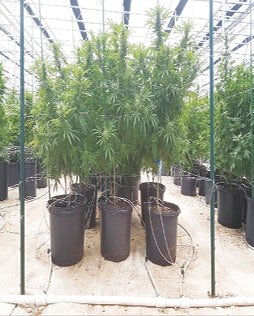At Strawberry Fields and Heartland Industries, we like to think of our canopy as the body of the beast, and the root zone as the stomach. If you are growing in perpetual production and not rooting directly in the earth, you should seriously consider what type of container you use to house your root zone for maximum health and nutrient uptake.
When selecting pot sizes, a few key factors should apply so that the roots/stomach of your organisms have the greatest chance of success with the heaviest, high-quality yield.
1. Increase pot size at different growth stages.

While we wish that we could just place a clone into its final pot size (10 to 20-plus gallons) and send her out to pasture for some effort-free flowering, cannabis roots tend to shoot to the base of the pot and fill the bottom 2 inches of the available soil space, leaving the rest untouched. One way to combat this is to stage up the clone from a clone container to a 12-ounce pot, to a 1-gallon, from there to a 5-gallon and then on to a finishing size of a 10- to 20-gallon container. However, view this as a trade-off with the labor and costs it takes with added plant touches.
2. Place the plants near the top of the pot.
With each potting upgrade, it is important to transplant the plant at the top of the pot, one inch under the lip of the container so the roots have the greatest chance to fill out the entire area of the container’s soil.
3. Bigger is not always better.
I’ve seen entire crops that would have been better grown in much smaller pots with less medium. All that waste drove up the overall operational costs and ended up being flushed dollars. Granted, many other variables exist, but if the stomach of the beast is not healthy, she won't bear quality bud.
4. Handle your plants with care.
Another mistake I see some folks make is how they will move the plants from one room to another. Employees who don’t care all that much about each plant can grab the edge of the pot and move it in a jerky manner, carry it horizontally and cause the canopy to fall over. Ripping any tissue at the plant’s base due to the canopy of the plant bending over is a crucial mistake, and only sets you back while the plant takes the time to heal. Think of giving a prize fighter a spinal injury four weeks before her match. How well will she fight now? About as well as your plant will flower.
When it comes to containers, put some consideration and planning into the different stages of your operation before executing the plan. Design it and tweak it with what works best for you, don't just keep growing by default with the same problems when the solution could be something as simple as pot size.
















